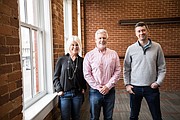Does remote work work? It depends on who you ask.
"We hire on potential, so there's a lot of training that goes on, and it's easier to train in person for the most part," says Rob Reagan, the chief technology officer for Text Request, which moved in May into its new 7,200-square-foot headquarters on Market Street in downtown Chattanooga. "I think culture is what sets us apart as a competitive advantage, and it's really hard to get the culture if the only contact is Google Meet or Zoom and the random channel on Slack."
Meanwhile, a few blocks away at the Cherry Street headquarters of FreightWaves, the building is largely empty after the company shifted permanently to remote work in August 2020. CEO Craig Fuller has held onto the 22,000 square feet of space downtown for use as a media production studio and for optional social gatherings for work teams, but most employees are all in on working from home, Fuller says.
"Ultimately, we're selling information, providing information, and that can be done anywhere," says Fuller, whose logistics data and media company has about 130 employees. "If there was a clear level of revenue growth where we felt like being in the office would accelerate growth we'd be in the office in a heartbeat."
To make matters even less clear, both Text Request and FreightWaves are among the fastest growing technology companies in the country, each scoring spots on the Deloitte Fast 500 list for the first time in 2021.
Text Request, with about 30 employees and counting, builds text messaging software for small businesses, and grew 1,355% from 2017 to 2020. The data arm of the FreightWaves business grew 651% in the same period.
The question of whether in-person or remote work is better for businesses and employees may not have an easy, one-size-fits-all answer, but there's no question working from home (or wherever you happen to be) has moved from emergency measure to everyday occurrence, according to recent research from Gallup.
In September polling, 67% of employees in white-collar jobs reported working from home either exclusively (41%) or some of the time (26%). And 45% of full-time U.S. employees worked from home either all (25%) or part of the time (20%).
In-person and remote work each have clear advantages, as well as inherent disadvantages, says Jason Provonsha, the CEO of Steam Logistics, another growth success story that has committed to in-person work.
"I'm sure we've lost some people that just don't want to be in-office, but we've also hired more than 300 people this year so we're making it through," Provonsha says. "We're trying to be a legacy business in our industry and Chattanooga and aggressively trying to realize those goals, so our point of view is if we're doing this together in person, we can do it better and faster and have more fun along the way."
Steam Logistics, which has grown 1,000% in the last two years, recently unveiled plans to renovate the John Ross building at Fourth and Market streets, and grow its roughly 450-person workforce by another 400 employees in the building's 60,000 square feet.
The company expanded its third-party logistics services in 2021, adding a national offering to its international services. The wide-open, in-person workplace has been a critical element of Steam's success in supporting clients across those borders, Provonsha says.
"I question whether or not we would have been able to do what we've done had we not come back [to the office]," he says. "This business is operating at a pretty high pace, and so when you're having to make decisions in real time and make changes in real time to a previous plan, it moves so much more quickly. That's why we have an open office environment - you can reach across the aisle, you can stand up and yell at somebody across the room."
At American Exchange, which provides health insurance navigation and billing services, the move to remote work has allowed the company to become geography agnostic in its hiring, says John Smith, vice president of Sales and Development.
"We're now hiring across Florida, North Carolina, Virginia," he says. "As remote has become an option, our talent pool has gotten broader, and the expectations of employees have changed."
The company has about 50 employees, and shifted in 2020 to a fully remote workforce from an entirely in-person model. Another upside of that shift was the ability to lease a smaller space and save some money on real estate, Smith says. The company's office in Liberty Tower downtown is configured very differently from the previous open office space, Smith says.
Remote vs. in-person
Remote work teams:American Exchange* Business: Health insurance navigation and billing services* Employees: About 50* Workplace: Moved to a fully remote workforce in 2020, and downsized into a new downtown Chattanooga headquarters to offer a workspace for employees who prefer to be in the office“We’re now hiring across Florida, North Carolina, Virginia. As remote has become an option, our talent pool has gotten broader, and the expectations of employees have changed.” — Vice President of Sales and Development John SmithFreightWaves* Business: Logistics data and media* Employees: About 130, with half in Chattanooga* Workplace: Moved to a fully remote workforce in 2020, but maintains a downtown headquarters for regular, optional gatherings and as a workspace for broadcast media“If there was a clear level of revenue growth where we felt like being in the office would accelerate growth we’d be in the office in a heartbeat.” — CEO Craig FullerOffice-based teams:Steam Logistics* Business: Third-party logistics* Employees: About 450, with plans to hire 400 more* Workplace: In-person in offices on Market Street, with plans to renovate and expand into the nearby John Ross building in late 2022“We’re trying to be a legacy business in our industry and Chattanooga and aggressively trying to realize those goals, so our point of view is if we’re doing this together in person, we can do it better and faster and have more fun along the way.” — CEO Jason ProvonshaText Request* Business: Text-based technology services* Employees: About 30, with plans to add several more* Workplace: Moved in May 2021 from headquarters on the Southside to in-person offices on Market StreetWe want to work together, interact together, enjoy being with each other as well as enjoy what you’re doing. It’s that simple — enjoy what you do, love who you’re doing it with, and that’s what we try to do.” — Co-founder Jamey Elrod
"Our new office is smaller, and there are more individualized offices and some shared workspace, so there's more of a flexible space rather than one giant open space," he says. "That allows people to come in and have some personal space, and we have the flexibility for folks to work a kind of hybrid role."
While more than 90% of employees are working entirely at home, there's a small group - himself included - that likes the option of coming to the office, Smith says.
"Especially for our extroverted staff, I need them to be happy and get the stimulation they need, and they have to find a way to do that on their own if they're remote," he says. "You have to check in with people. That has become more important than ever."
The national Gallup polling shows that splitting the difference appeals to more than half of employees. Overall, 54% of employees who work remotely at least some of the time say they would ideally like to split their time between working at home and in the office. Only 9% want to return to the office full time, while 37% want to work from home exclusively.
And even at companies that are in-person first, there's often some flexibility for roles that lend themselves to remote work. At Text Request, a few software developers live outside Chattanooga, and others just work better away from the office, Reagan says.
"One [developer] spends several days a week at home, he's more productive at home," Reagan says. "He's heads-down, cranking out code. He's the woodchipper; we feed tasks in and product comes out the other side."
On both sides of the in-person versus remote-work dilemma, there are gray areas and room for flexibility, Provonsha says.
"It comes down to what you're trying to be as a business, what your culture is, what your goals are," he says.
READ MORE
* Help Wanted (Please!): Recruiters have to get creative to find top talent in a tight labor market

